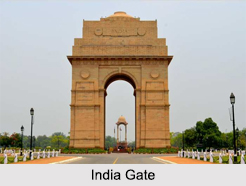 The major part of Indo-Gangetic plain or the North fertile plain forms Uttar Pradesh. Known as UP since the Raj Days, Uttar Pradesh, the Northern State of India is the heart of Hinduism. The history of Uttar Pradesh is very much the history of India. The area of UP was occupied by Aryans or the Dasas and their main occupation was agriculture. The Aryans through conquests occupied the areas. They laid the foundations of Hindu civilization. It was during the Aryan inhabitation that the epics of Mahabharata, Ramayana, the Brahamanas and Puranas were written.
The major part of Indo-Gangetic plain or the North fertile plain forms Uttar Pradesh. Known as UP since the Raj Days, Uttar Pradesh, the Northern State of India is the heart of Hinduism. The history of Uttar Pradesh is very much the history of India. The area of UP was occupied by Aryans or the Dasas and their main occupation was agriculture. The Aryans through conquests occupied the areas. They laid the foundations of Hindu civilization. It was during the Aryan inhabitation that the epics of Mahabharata, Ramayana, the Brahamanas and Puranas were written.
Ancient history of Uttar Pradesh
The state was the heart of Mahabharata war. The Khosala Kingdom of Ayodhya is said to have been incarnated in the city of Mathura. The Chaukhandi Stupa here marks the spot where Lord Buddha met his disciples. The Dhamek Stupa in Sarnath commemorates Buddha`s first sermon. Besides the Kurus and Panchalas the Vatsas, the Kosis, Hosalas, Videhas etc. formed the early region of Uttar Pradesh. These areas were called Madhyadesa. During the rule of Ashoka, works for public welfare was taken up. Buddhism and Jainism came into this region during the rule of the Magadha Empire. It was a period of administrative and economic advancement.
Till 320 AD, the Kushanas exercised their power here. From their hands the territory passed into the hands of the Guptas. It was during their rule, the Huns invaded this region. After the decline of the Guptas, the territory passed into the hands of the Maukharis of Kannauj. Kannauj District was an administrative district of Uttar Pradesh state in northern India. The region became the heart of Harshavardhana`s empire, from Punjab to Bengal. Modern communities in different parts of India -- Kashmir, Rajasthan, Uttarakhand, Bihar and Bengal, often trace their lineage to Kannauj. During this period the Muslims invaded into Uttar Pradesh. Then the Rajputs, Jats and other local chiefs dominated the society.
Medieval history of Uttar Pradesh
After 1000AD, Uttar Pradesh became part of Muslim Sultanates. During the Mughal rule U.P. became the heartland of what was called `Hindustan`, a name that was used to refer to India.
Agra and Fatehpur Sikri gained importance as the capital city of Akbar, who was the great Mughal Emperor of India. After the decline of the Mugahls, many kingdoms arose as Oudh, Rohilkhand , Bundelkhand, Benaras and Nepal. It was in the 17th century, that the Muslims established the city of Oudh.
Modern history of Uttar Pradesh
During the later half of the 18th century British ascended to the last Mughal territory which included the Doab, Bundelkhand, Kumaon and Banaras divisions. Delhi, Ajmer and Jaipur were also included in this territory. They called it as the North western provinces. The capital was shifted twice between Agra and Allahabad.
In 1803 the British controlled this region and in 1856 seized it. During the period of 1857-58, the first struggle for liberation from the British yoke was unleashed. The revolt was badly suppressed and till independence, the state remained under the control of the British.
In 1857, after the failed freedom war the British made a major revamp and truncated the Delhi region and gave it to Punjab, and the Ajmer-Mewar region to Rajputana. It was in 1950 that the state was structured and named as Uttar Pradesh.



















